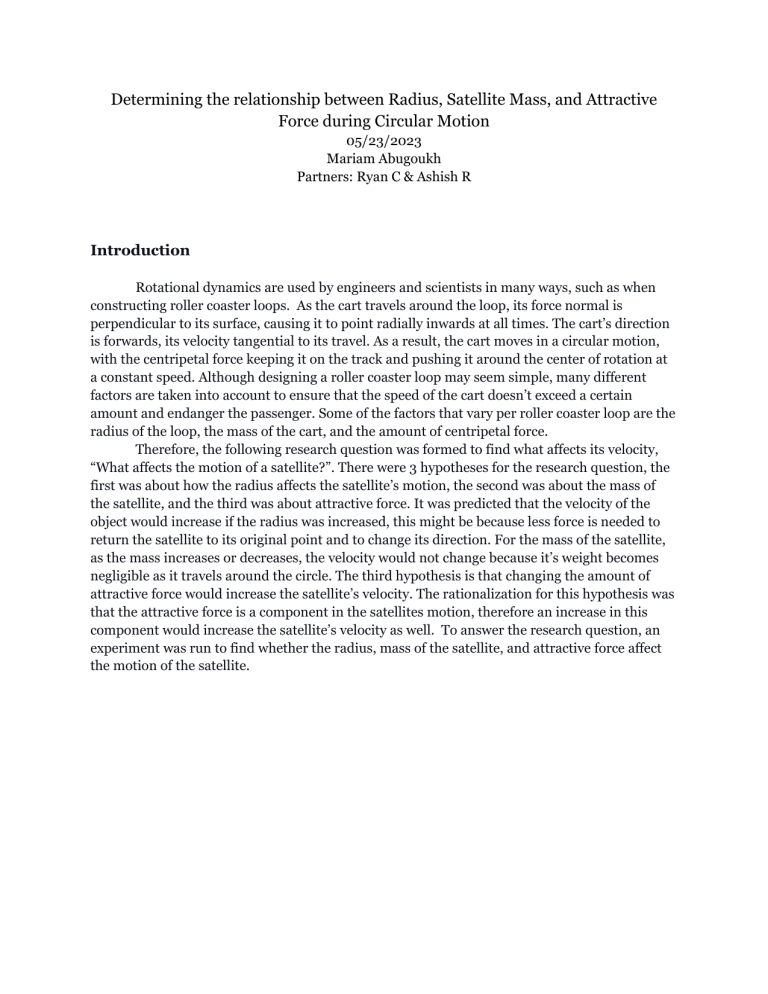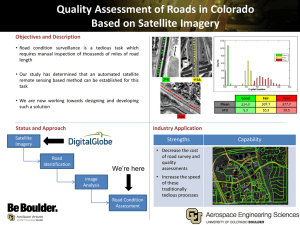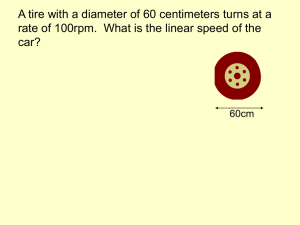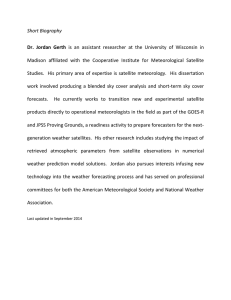
Determining the relationship between Radius, Satellite Mass, and Attractive Force during Circular Motion 05/23/2023 Mariam Abugoukh Partners: Ryan C & Ashish R Introduction Rotational dynamics are used by engineers and scientists in many ways, such as when constructing roller coaster loops. As the cart travels around the loop, its force normal is perpendicular to its surface, causing it to point radially inwards at all times. The cart’s direction is forwards, its velocity tangential to its travel. As a result, the cart moves in a circular motion, with the centripetal force keeping it on the track and pushing it around the center of rotation at a constant speed. Although designing a roller coaster loop may seem simple, many different factors are taken into account to ensure that the speed of the cart doesn’t exceed a certain amount and endanger the passenger. Some of the factors that vary per roller coaster loop are the radius of the loop, the mass of the cart, and the amount of centripetal force. Therefore, the following research question was formed to find what affects its velocity, “What affects the motion of a satellite?”. There were 3 hypotheses for the research question, the first was about how the radius affects the satellite’s motion, the second was about the mass of the satellite, and the third was about attractive force. It was predicted that the velocity of the object would increase if the radius was increased, this might be because less force is needed to return the satellite to its original point and to change its direction. For the mass of the satellite, as the mass increases or decreases, the velocity would not change because it’s weight becomes negligible as it travels around the circle. The third hypothesis is that changing the amount of attractive force would increase the satellite’s velocity. The rationalization for this hypothesis was that the attractive force is a component in the satellites motion, therefore an increase in this component would increase the satellite’s velocity as well. To answer the research question, an experiment was run to find whether the radius, mass of the satellite, and attractive force affect the motion of the satellite. Experimental Method The independent variables for the three sets of experiments is the radius/length of the string, the mass of the satellite, and amount of attractive force. Figure 1: Top view labeled diagram of satellite in circular motion, including radius and attractive force Instead of using designated masses for the satellite, the satellite is measured in stoppers, and increased when a larger mass must be tested. The attractive force is measured in washers, and turned into a force using gravitational force, which is then used as a tension. The force is increased by increasing the amount of washers. The dependent variable for all three experiments is the velocity of the satellite/stoppers. The controls for the experiment were the other two variables not being tested. Meaning that the “base” or default for the three variables were 0.3 meters of string, 20 washers, and 3 stoppers. When testing the radius, 20 washers were used for the attractive force and 3 stoppers were used for the satellite. The radii tested were 0.3 meters, 0.35 meters, and 0.4 meters. When testing the attractive force, the radius was set to 0.3 meters and the satellite was set to 3 stoppers. The masses that were used for the attractive force were 20 washers, 25 washers, and 30 washers. When testing the mass of the satellite, the radius was set to 0.3 meters and the mass of the attractive force set to 20 washers. The satellite masses tested were 3 stoppers, 2 stoppers and 1 stopper. The constant in the experiments was gravitational acceleration. The materials needed to conduct the experiments were 30 washers, 3 stoppers, at least 0.45 meters of string, a stopwatch, a plastic tube, a camera, a meter stick, and a marker. First, the amount of stoppers tested or kept controlled was tied to the end of the string and 3 different measurements were marked starting at the stopper(s), 0.3m, 0.35m, 0.4m. The end of the string was threaded through the tube, and the amount of washers being tested or controlled was tied to the end. Figure 2: Side view labeled diagram of satellite in circular motion, with components used Then, the stoppers/satellite is spun for 3 revolutions while its travel is recorded and timed. This process is repeated for all three independent variables, only changing one at a time and keeping the other two at the controlled value, each for three trials. The main safety precaution taken during this experiment was to stay away from the orbiting satellite, as it could hurt the researchers. It was ensured that all researchers stayed at least a meter away from the spinning projectile. Data Satellite Time and Angle during 3 Revolutions for each Radius Radius(m) Time for 3 Rev.(s) Angle of Ft(°) Trial 1 2.15 63 Trial 2 2.1 63 0.3 Trial 3 2.02 69 Trial 1 2.21 58 Trial 2 2.16 57 0.35 Trial 3 1.68 58 Trial 1 2.46 58 Trial 2 2.45 57 0.4 Trial 3 2.51 55 Table 1: Raw data collected for the Satellite’s Time and angle for three revolutions for 3 trials when spun with varying radii Satellite Time and Angle during 3 Revolutions for each Attractive Force Mass Attractive Force Mass(# of washers) Time for 3 Rev.(s) Angle of Ft(°) Trial 1 2.15 63 Trial 2 2.1 63 20 Trial 3 2.02 69 Trial 1 2.25 47 Trial 2 2.27 41 25 Trial 3 2.24 60 Trial 1 2.03 61 Trial 2 2.12 47 30 Trial 3 2.2 59 Table 2: : Raw data collected for the Satellite’s Time and angle for three revolutions for 3 trials when spun with varying Attractive Force masses Satellite Time and Angle during 3 Revolutions for each Satellite Mass Satellite Mass(# of stoppers) Time for 3 Rev.(s) Angle of Ft(°) Trial 1 2.15 63 Trial 2 2.1 63 3 Trial 3 2.02 69 Trial 1 1.91 65 Trial 2 1.81 67 2 Trial 3 1.76 67 Trial 1 1.43 73 Trial 2 1.47 66 1 Trial 3 1.31 73 Table 3: Raw data collected for the Satellite’s Time and angle for three revolutions for 3 trials when spun with varying Satellite masses Results Averaged Satellite Time and Angle during 3 Revolutions for each Radius Radius(m) Time for 3 Rev.(s) Angle of Ft(°) 0.3 2.09 65 0.35 2.016666667 57.66666667 0.4 2.473333333 56.66666667 Table 3: Averaged data collected for the Satellite’s Time and angle for three revolutions when spun with varying radii Averaged Satellite Time and Angle during 3 Revolutions for each Attractive Force Mass Attractive Force Mass(# of washers) Time for 3 Rev.(s) Angle of Ft(°) 20 2.09 65 25 2.253333333 49.33333333 30 2.116666667 55.66666667 Table 4: Averaged data collected for the Satellite’s Time and angle for three revolution when spun with varying Attractive Forces Averaged Satellite Time and Angle during 3 Revolutions for each Satellite Mass Satellite Mass(# of stoppers) Time for 3 Rev.(s) Angle of Ft(°) 3 2.09 65 2 1.826666667 66.33333333 1 1.403333333 70.66666667 Table 5: Averaged data collected for the Satellite’s Time and angle for three revolution when spun with varying Satellite Masses The velocity was calculated by finding the quotient of the time per revolution and the circumference, which was calculated using the angle and the length of the string. Because the string wasn’t perpendicular to the plastic tube, the radius of the satellite’s circular travel decreased. To account for the smaller radius, trigonometry was used to find the horizontal distance from the pole to the satellite. The formula used, where S is the length of the string, a of the angle created between the tube and string, and R of the radius of the satellite’s travel, was: R=Stan(a) Then, the new radius was used to find the circumference of the satellite’s travel. The formula used, where R is the radius and C is the circumference, was: C=2πR Additionally , the time per revolution of the satellite was found using the following formula, where P was the time per revolution and L the time it took to complete 3 revolutions, was: P=L/3 Lastly, the quotient of the circumference and time per revolution is found to calculate the velocity. The formula used, where C is circumference, P the time per revolution, and V for velocity, is: V=C/P A sample calculation for finding the velocity for the satellites travel with 1 stopper attached to it during the 3rd trial is shown below: 0.3mtan(73) 0.276m 0.276m is the radius of the satellite. The rest of the equation for finding the circumference is shown: 2π0.276m 1.733m The circumference of the satellite’s circular travel is 1.733m. Then the period is found and used with the circumference to find the satellite’s speed: 1.31s/3 0.437s/rev 0.437s/rev is the satellite’s period, and is then used to find the velocity: 1.733m/0.437s 3.966m/s 3.966m/s is the velocity of the satellite as it travels around the circular path. Circumference, Period, and Velocity of Satellite for each Radius Radius(m) Circumference(m) Period(s/rev) Velocity(m/s) 0.3 1.708349931 0.6966666667 2.452176935 0.35 1.858143895 0.6722222233 2.764180997 0.4 2.099809897 0.6466666667 3.247128707 Table 6: Circumference, Period, and Velocity of the satellite and its travel varying by Radius Circumference, Period, and Velocity of Satellite for each Attractive Force Mass Attractive Force Mass(# of washers) Circumference(m) Period(s/rev) Velocity(m/s) 20 1.708349931 0.6966666667 2.452176935 25 1.429764349 0.7511111111 1.903532418 30 1.556540362 0.7055555556 2.206120197 Table 7: Circumference, Period, and Velocity of the satellite and its travel varying by Attractive Force Circumference, Period, and Velocity of Satellite for each Satellite Mass Satellite Mass(# of stoppers) Circumference(m) Period(s/rev) Velocity(m/s) 3 1.708349931 0.6966666667 2.452176935 2 1.726423775 0.6088888889 2.835367513 1 1.778660131 0.4677777778 3.802361326 Table 8: Circumference, Period, and Velocity of the satellite and its travel varying by Satellite Mass Figure 3: Graph of the satellite’s velocity varying by radius Figure 4: Graph of the satellite’s velocity varying by Attractive Force Figure 5: Graph of the satellite’s velocity varying by Satellite Mass Discussion One of the assumptions for this experiment was that the length of the string stayed at the same value. This was important because the experiment couldn’t be conducted for testing the radius’s effect on the velocity otherwise. Another assumption was that the circular travel of the satellite was perpendicular to the ground, which was important as speed could be lost counteracting gravity. One of the reasons that could’ve caused error in the experiment was the assumption that the radius stayed the same. This could’ve caused errors and made testing the radius not effective. Another source of error was that the angle measured wasn’t constant throughout the satellite’s travel, therefore the angle used to find the new radius might not be accurate. The first hypothesis, that velocity increases with radius, was supported by the data collected. According to Figure 3, with the tested radius 0.3m, the velocity was about 2.5m/s, and with the radius 0.4m, it was at around 3.25m/s. Meaning the relationship between velocity and the radius is directly proportional, with a high R^2 of 0.985. The second hypothesis was that the attractive force would increase the velocity of the satellite, and it was not supported by the data due to a low R^2 value of 0.2 as seen in Figure 4. This result might’ve occurred because of the low angle between the tube and the string, creating friction and causing it to slow down. The final hypothesis was about how satellite mass doesn’t affect its velocity. This wasn’t proven by the data collected, as in Figure 5, the trendline has a high R^2 value with an inverse relationship between mass of the satellite and velocity. One reason this might’ve happened was that more force was used to spin the satellite when it was lighter, causing it to spin at a higher velocity.


